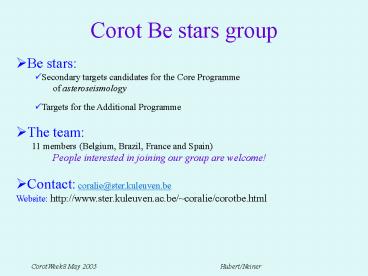Corot Be stars group - PowerPoint PPT Presentation
1 / 20
Title:
Corot Be stars group
Description:
Giraffe: a multi-object spectrograph. CorotWeek8 May 2005. Hubert/Neiner. VLT-GIRAFFE: a multi-object spectrograph. In Medusa mode: 132 fibers. R=7500 and 25000 ... – PowerPoint PPT presentation
Number of Views:19
Avg rating:3.0/5.0
Title: Corot Be stars group
1
Corot Be stars group
- Be stars
- Secondary targets candidates for the Core
Programme - of asteroseismology
- Targets for the Additional Programme
- The team
- 11 members (Belgium, Brazil, France and
Spain) - People interested in joining our group are
welcome! - Contact coralie_at_ster.kuleuven.be
- Website http//www.ster.kuleuven.ac.be/coralie/c
orotbe.html
2
Be stars as potential targets for the Additional
Programme
- Science goal for Be stars
- About 70 Be stars with 6ltVlt9.5 in the cones of
COROT (seismology fields) including 15 new Be
stars with Vlt8.0 (GAUDI) (Neiner, Hubert, Catala
2005) - Candidates for pulsations, rotation, activity,
binarity studies (short runs) - Faint Be stars with 12ltVlt16.5 in the exoplanet
fields - Candidates for asteroseismology (long runs)
3
? Preparatory programs for bright Be stars
- Photometric variability
- Strömgren photometry (0.9m-T in Granada)
periodicity in early Be stars candidates
(Gutierrez-Soto et al. 2003) and even
multiperiodicity for NW Ser and V1446 Aql
(Fabregat, this COROTWeek) - Spectroscopic variability (LNA OHP multisite)
- Determination of fundamental parameters taking
into account fast rotation and veiling (Frémat,
et al. 2005) - Search for magnetic fields (EsPaDoNS, CFHT)
4
- Determination of stellar parameters
- Data GAUDI OHP LNA FEROS
- Rapid rotation ? stellar flattening
gravitational darkening effects - FASTROT (Frémat Zorec)
- - assumes Rigid rotator (Roche model) ? log g
- Von Zeipel law ? Teff
- Local model atmospheres
- - LTE temperature and pressure distribution
- (ATLAS9, Kurucz)
- - NLTE level populations (TLUSTY, Hubeny Lanz)
- CS envelope ? veiling effect
5
- From modeling of different spectral domains ?
Teff, logg, Vsin i and i for a given ?/?c
Without correction for rotational effects Teff
25450 ? 1000K, log g 3.87 ? 0.10 V sini 310
? 30 km/s
With corrections for ?/?c 0.9 (value adopted
from Frémat, Zorec et al., in press) Teff
26000 ? 1000K, log g 4.10 ? 0.10 V sini 325
? 30 km/s, i 60
observed spectrum fitted spectrum
6
Location of Be stars in the HR diagram
Without correction for rotational effects
With corrections for ?/?c0.9
7
Different Be star spectral distributions between
the Galactic Centre and Anticentre ? to be
related to the insterstellar absorption, more
important towards the Galactic Centre (Lucke
1978)
Be stars spectral-type distribution in the cones
of COROT
(Frémat, Neiner, Hubert, Floquet, Zorec,
Janot-Pacheco, de Medeiros, 2005, submitted)
8
? Preparatory programmes for faint Be stars
- Detection of Be stars in the exoplanet fields
- Spectroscopy at ESO with VLT/GIRAFFE
- Part of a programme on the Guaranteed Time
Observations of the Observatoire de Paris
devoted to spectral classification and precise
type identification in exoplanet fields of COROT
(G. Alecian P.I., Hubert, Deleuil, Neiner,
Martayan, Floquet) - To validate the method of spectral classification
for exoplanet stellar database - (Deleuil et al.)
- To determine fundamental parameters
- To identify specific groups of stars, Hg-Mn,
Befor Additional Programmes of COROT
9
Giraffe a multi-object spectrograph
10
VLT-GIRAFFE a multi-object spectrograph
In Medusa mode 132 fibers R7500 and
25000 Required astrometric precision
0.2 Field ?25 Fibers Minimal separation
12
11
? Anticentre direction
2 GIRAFFE fields observed (?26) next to HD
49933HD 49434 About 35 B0-A5 candidates in each
field (exodat catalog by Deleuil et al.)
- 2 Be
- 31 B0-A0 (Teff 9500K)
H?
(Alecian, Martayan et al. in preparation)
12
Fundamental parameters B stars -LTE temperature
and pressure distributions (ATLAS9,
Kurucz) -NLTE level populations (TLUSTY, Hubeny
Lanz)
- Teff13615K, log g3.95
- V sini65 km/s, RV49 km/s
Example of fit for a B star observed
spectrum fitted spectrum
13
- Be stars
- Teff20860K, log g3.93
- V sini260 km/s RV55 km/s
- Teff15100K, log g3.40
- V sini297 km/s RV59 km/s
14
- Detection of Be stars in the exoplanet fields
- Photometry at Granada, Spain
- uvby H?,H? narrow filters (J. Fabregat,
Gutierrez-Soto, Suso) - Starting point emission line stars catalogue of
Robertson Jordan (1989) ( but Vlt14!) - No information on spectral types is available
- Observations at Calar Alto (Almeria, Spain)
- Provide spectral classification for RJHA stars
- Find new Be stars in exoplanet fields
15
Photometry of emission line stars in potential
exoplanet fields to identify B stars
Diagram without reddening m1-c1 5 emission
line stars of RJ are B stars
(from Fabregat et al. 2003, CorotWeek 4)
16
- IR photometry with Spitzer
- 4 fields observed with IRAC 2 at
HD4993349434, 2 at HD52265 - 4 IR colors (3.6,
4.5, 5.8 et 8.0 mm) for each field JHK colors
from 2MASS visible colors and extinction from
the exoplanets WG
4 Corot CCDs
2 Spitzer fields
17
2 fields next to HD 4993349434
18
2 fields next to HD 52265
19
Examples
Possible Be star observed with Spitzer
Typical Be star SED
2MASS
Be
Black-body B
B
IR excess
(Neiner et al. in preparation)
Spitzer colors
20
Next Future
- Characterization of bright Be stars almost
finished - Search for faint Be stars still in progress
- a small number of detections only!
- But new data!
- VLT/GIRAFFE spectra (Centre direction), SPITZER
data - And new proposals!
- -WFI ubvyr and H? filters at INT, Canaries
- (Fabregat, Neiner, Gutierrez-Soto et al.)
- - spectroscopy T1.6m at LNA and T4m-SOAR,
(R6000, visible R3000, IR), Brazil Chile - (Janot-Pacheco, Andrade)
We need positions of hot stars from exoplanet
database!

